Table of Contents
Expert’s Rating
Pros
- Outstanding main camera
- Impressive performance
- Excellent Android 14 software
- Six more years of updates
Cons
- Underwhelming battery life
- Slow charging
- No telephoto camera
Our Verdict
The Pixel 8’s price hike compared to the Pixel 7 has been reversed in the UK, making it a much better buy than at launch. With the Pixel 9 even more expensive, this older model is definitely worth considering, especially with software updates continuing until 2030. However, you might have a harder time justifying it in the US, where the price hasn’t changed.
Price When Reviewed
From $699
Best Prices Today: Google Pixel 8
If 2023 was the year of AI, the Pixel 8 and 8 Pro showcase it more than any other phones.
Artificial intelligence is used to optimise performance, take and edit photos, summarise webpages, screen calls and even create personalised wallpapers.
The regular Pixel 8 gets all those features, but plenty more are exclusive to the more expensive Pixel 8 Pro. It’s no surprise to see the 5x telephoto lens missing and an inferior ultrawide camera, but you’ll also have to make do with a worse display, glossy finish, no temperature sensor and some missing software features.
Are those compromises worth it in order to save a few hundred pounds/dollars? Ultimately, that depends on what you’re looking for in a phone.
It’s worth noting that the Pixel 9 series is now official, but this older model is much cheaper than its successor.
Design & Build
- Compact yet premium design
- Glass back attracts dirt
- Lightweight, but still durable
After years of experimenting with the design of its phones, Google handsets now have a very clear identity. And aside from more rounded corners, not much has changed on the Pixel 8.
It means the striking camera visor still extends all the way across the top of the phone. I’m not a huge fan of the way it looks, and but you can’t argue it’s not distinctive. Camera modules continue to be one of the main ways a phone stands out from the competition, though you will have to put up with dirt accumulating above and below the visor.
Anyron Copeman / Foundry
While both the Pixel 8 phones have glass backs, the regular model has a glossy finish rather than the matte on the 8 Pro. Even on the Hazel model I tested, it began showing fingerprint smudges and other dirt within a couple of minutes of use. I’d expect the situation to be even worse on the Obsidian (black) and Rose (pink) versions.
However, the Mint model introduced in January 2024 does look particularly good in official photos.
Even so, I’d recommend a case. The official Google version adds plenty of grip and a nice splash of colour, but costs an extra $34.99/£34.99. As usual, there are plenty of third-party alternatives.
However, even without it, I wouldn’t be too concerned on the durability front. Both the front and back of the phone are equipped with Gorilla Glass Victus, which has been tested to survive drops of up to 2m and be resistant to scratches (though our Pixel 7 did crack a little on the corner when falling out of a car).
Maintaining great durability in such a lightweight, compact phone is impressive
And the Pixel 8’s IP68 rating is in line with most flagship phones. It means the device is fully protected against dust and can handle submersion in up to 1.5m of water for 30 minutes.
Maintaining great durability in such a lightweight, compact phone is impressive. The Pixel 8 weighs just 187g – a refreshing change compared to the huge Samsung Galaxy S23 Ultra (234g) that I usually use. It’s still not quite a one-handed phone, but very few smartphones are these days and it’s more compact than the Pixel 7.
The premium look and feel extends to the aluminium sides, but it took me a couple of days to get used to the placement of the physical buttons. On the Pixel 8, the power button is above the volume controls, the opposite of what we see on most Android phones.
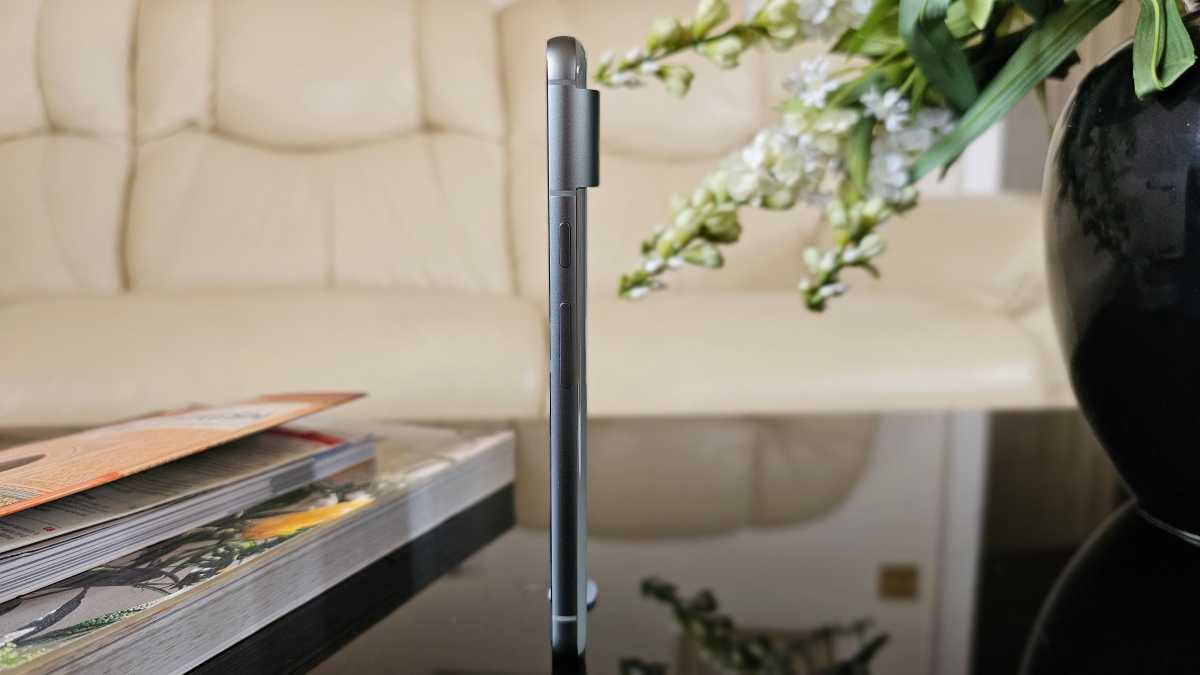
Anyron Copeman / Foundry
It means the power button is awkwardly high on the right side, but you need to press and hold both it and volume up to turn the phone off anyway. When you do, you’ll notice just how good the vibration motor is, enabling great haptic feedback in a variety of scenarios – including while typing.
Screen & Speakers
- Excellent 6.2in, 120Hz OLED
- Upgraded face unlock
- Decent stereo speakers
The Pixel 8 can’t be considered a small phone, but it is relatively compact by modern standards. Google has actually shrunk the display slightly to 6.2in (from 6.3in), making the difference between it and the 6.7in Pixel 8 Pro more clearly defined.
On paper, the screen itself doesn’t sound remarkable. We’ve seen 1080×2400 OLED panels many times before, but it still looks great on the Pixel 8, delivering rich, vibrant colours in the default ‘Adaptive’ mode. You can easily swap this for the ‘Natural’ setting that’s easier on the eyes, though – both look good.

Anyron Copeman / Foundry
Whichever you choose, the excellent deep blacks we’ve come to associate with OLED are evident, especially with a systemwide dark mode applied by default. A higher resolution could be nice, but I didn’t miss it; the Pixel 8’s screen offers plenty of detail, with all content looking clear and crisp.
The 120Hz refresh rate is the main display upgrade compared to the Pixel 7 at 90Hz, bringing it in line with most flagship phones. It’s a relatively subtle change in the grand scheme of things, but makes everything feel that bit more fluid and responsive.
However, you miss out on the Pixel 8 Pro’s LTPO tech, which allows the refresh rate to dynamically adjust down to 1Hz depending on what you’re doing and helps to conserve battery life.
The Pixel 8’s screen offers plenty of detail, with all content looking clear and crisp
Instead, the ‘Smooth display’ toggle on the Pixel 8 only switches between 60- and 120Hz, with the only manual option 60Hz. As nice as it is to have a 120Hz display, Google could’ve done a better job with its implementation here.
But one thing I can have no complaints about is brightness. I recorded a maximum of 950 nits using a SpyderX calibration tool, and visibility is great in all environments including direct sunlight. And as someone who’s not a fan of curved displays, I’m really glad Google went for a flat version here.
Within the display is an optical fingerprint sensor, which is simple to set up but annoyingly temperamental. I enrolled the same finger four times to improve the chances of a fast unlock, but it still often took several tries.
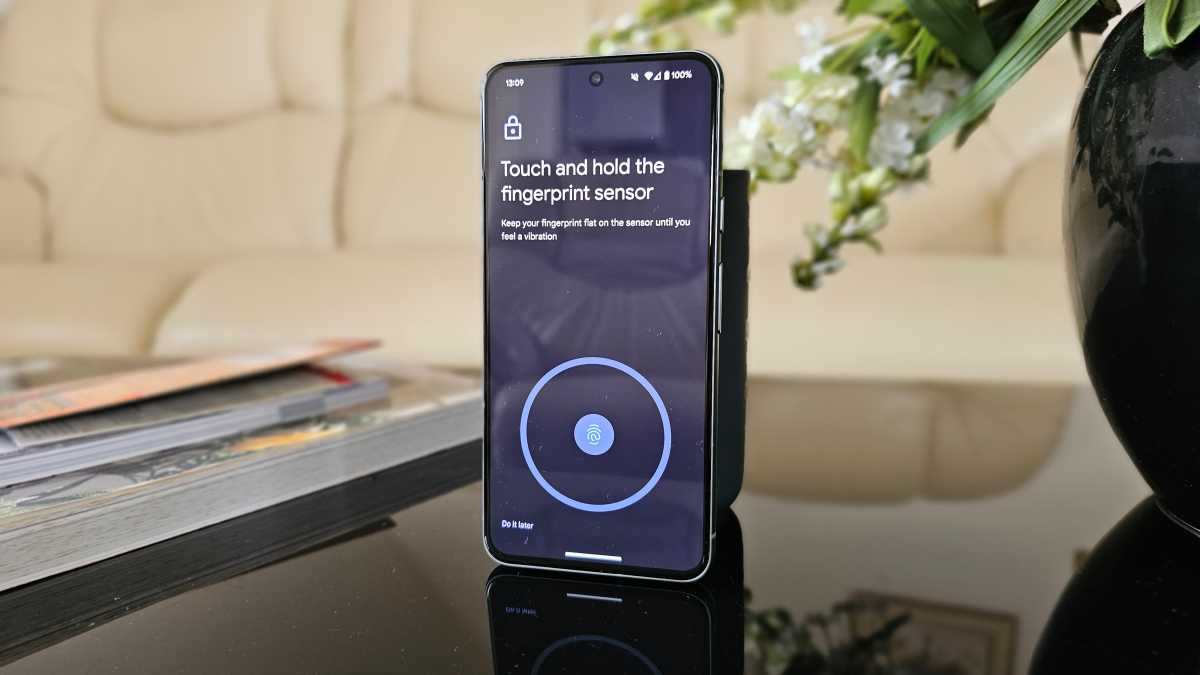
Anyron Copeman / Foundry
I’d recommend using the upgraded face unlock instead. For the first time in a Pixel phone, it’s secure enough to be used for the likes of Google Wallet and mobile banking apps, with the Tensor G3 chip supposedly the driving force.
While not quite as seamless as Apple’s Face ID, a key benefit is that you don’t need a notch or big pill-shaped cutout, just the usual punch-hole selfie camera. AI and ML (machine learning) are doing a lot of the work in the background, and the extra second or two it takes is well worth it for the extra security.
The Pixel 8 supports stereo audio, with sound emitted from two downward-firing speakers and the earpiece. It’s surprisingly punchy for such a small phone, with a decent amount of detail and solid mid-range frequencies.
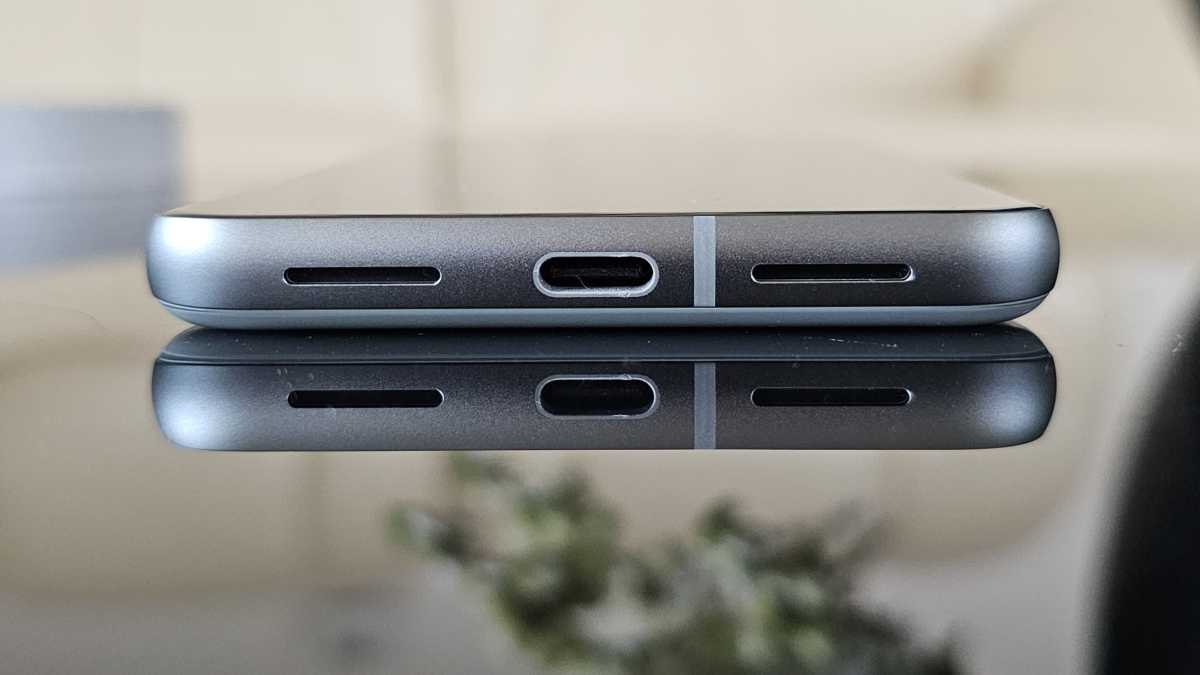
Anyron Copeman / Foundry
But as expected, bass and treble are both lacking, so you’ll need to connect headphones for anything more than casual listening.
Specs & Performance
- Google Tensor G3 and 8GB RAM
- Very good performance
- Only 128- or 256GB of storage
Google’s Tensor G3 chip is one of the main upgrades on the Pixel 8 line, and it’s available on both phones. New AI capabilities are its main selling point, but performance is also crucial.
Before testing the Pixel 8, I was concerned that only 8GB of RAM might make it feel sluggish, especially when the 8 Pro has 12GB, but I needn’t have worried.
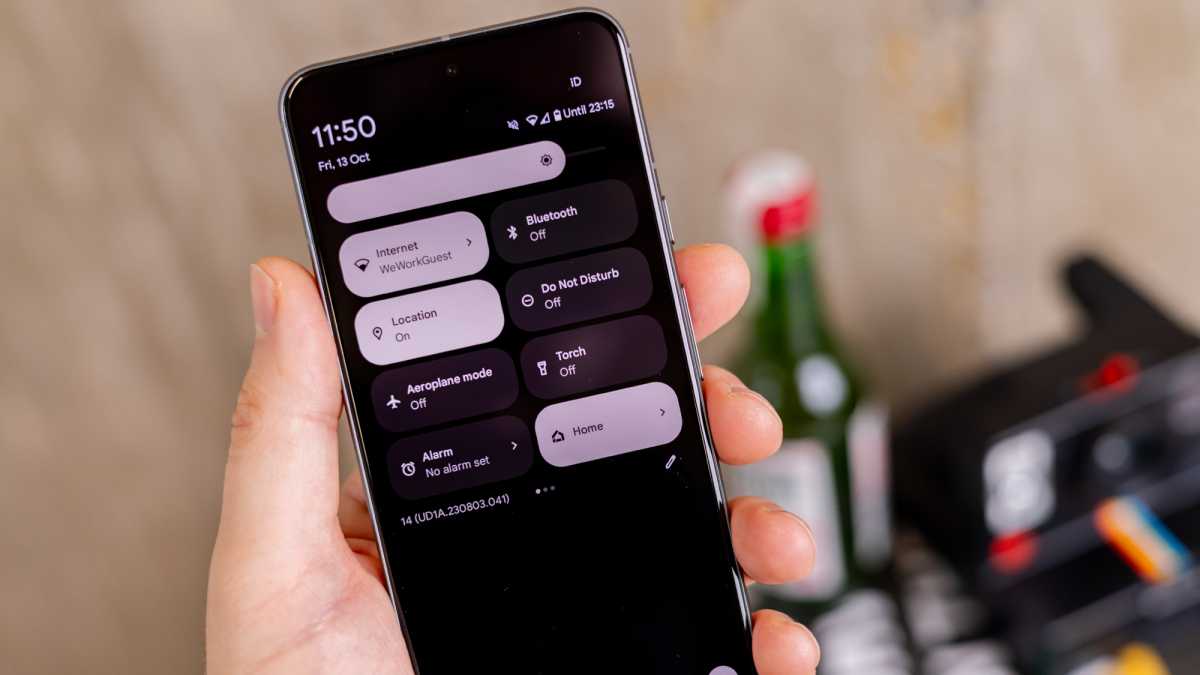
Dominik Tomaszewski / Foundry
Performance isn’t quite class-leading, but the Pixel 8 still offers more than enough power for the vast majority of people. My typical day involves lots of messaging, web browsing, navigation, taking photos and watching the occasional video. The Pixel 8 handled all that without even getting noticeably warm, even when quickly switching between them.
The Pixel 8 still offers more than enough power for the vast majority of people
I was also surprised by how well it handled demanding mobile games, with the likes of Asphalt 9 and Call of Duty: Mobile running without any noticeable stuttering or dropped frames. However, I’d still recommend a dedicated gaming phone if you’re really serious about it.
Combining the Tensor G3 with that 120Hz refresh rate means everything feels very slick and responsive, albeit not quite as rapid as Snapdragon 8 Gen 2 phones. That’s reflected in the benchmarks below, but it’s not a cause for concern.
Google Pixel 8 benchmarks
Disappointingly, there are only two options for internal storage: 128- or 256GB. With no option for microSD expansion and around 18GB taken up with system files, it’s worth paying the $60/£60 premium for 256GB if you’re at all unsure. It’s a shame the 512GB and 1TB options from the 8 Pro aren’t available in the UK, and just in the US.
There are some small upgrades to connectivity, though, and Wi-Fi 7 and Bluetooth 5.3 are more about futureproofing than use in 2023. And, of course, there’s 5G support.
Cameras & Video
- Superb main and selfie cameras
- Decent 12Mp ultrawide
- No telephoto
- Various AI editing features
Cameras have always been the main reason to buy a Pixel phone, and that’s even more true on the Pixel 8.
The 50Mp main sensor is the primary reason for this – it’s identical to the Pixel 8 Pro, and a slightly tweaked version of 50Mp found on the Pixel 7. Alongside Google’s superb (arguably unmatched) software processing, the Pixel 8 can’t be beaten when it comes to point-and-shoot smartphone photography.
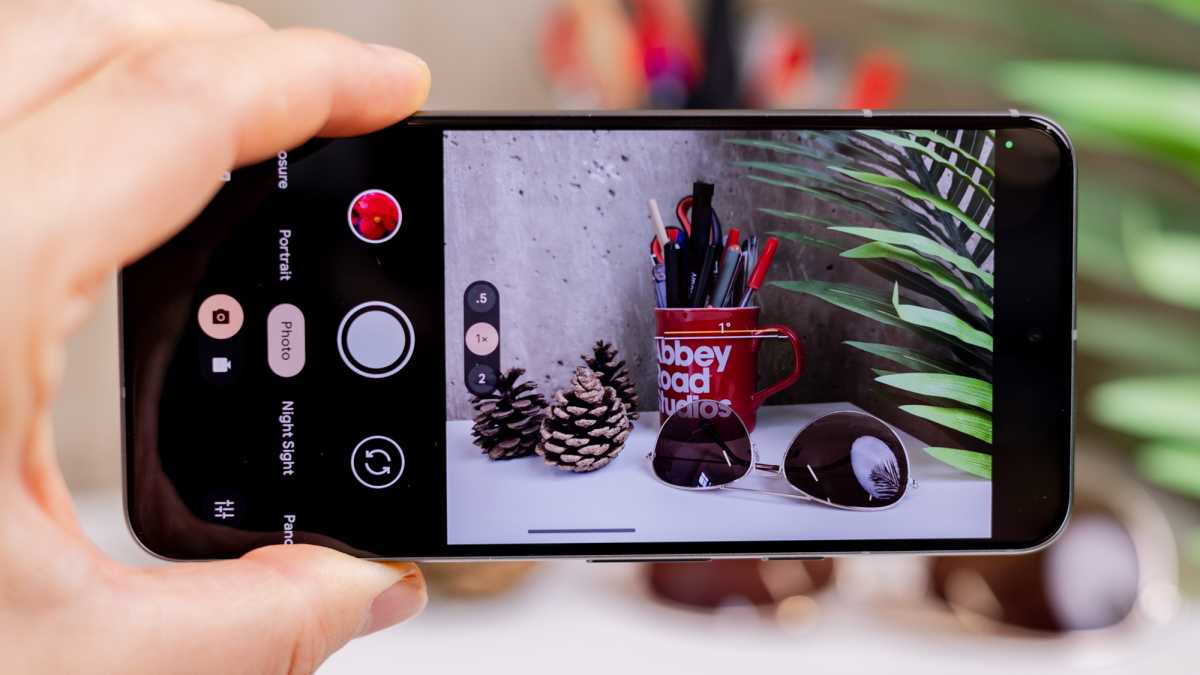
Dominik Tomaszewski / Foundry
I tested the camera in a variety of scenarios, and there were no weaknesses. Detail, dynamic range and exposure are all consistently excellent, whether you’re capturing an expansive landscape or building up close.
The image processing isn’t true to life, but I think the subtle boosts to saturation and contrast match how most people would want to edit them. And if you don’t like what Google is doing here, you can always shoot in RAW and make manual changes yourself.
Unfortunately, the 12Mp ultrawide lens is a significant downgrade compared to the equivalent 48Mp sensor on the Pixel 8 Pro. Images are noticeably less detailed as a result, but the powerful software processing means they’re still very usable unless you zoom in. Colours and exposure are still very impressive.
The Pixel 8 can’t be beaten when it comes to point-and-shoot smartphone photography
Night Sight is available on both the main and ultrawide lenses, and it does a very good job of brightening low-light shots while still maintaining key details. It’s one of the most impressive night modes I’ve used.
But with the 48Mp telephoto lens totally missing here, there’s no optical zoom at all, so you’ll have to rely on the digital version instead. Of course, this isn’t quite as good, but it does a remarkable job of preserving details, even at the maximum 8x.
There are no downgrades when it comes to the front camera, though. Despite a seemingly low res 10.5Mp sensor, the Pixel 8 is capable of taking excellent regular and ultrawide shots. Detail and dynamic range are also excellent here, and it handles exposure very well.
The software also enables excellent portrait shots, both from the main and selfie cameras. Subjects are crisp and well-lit, while edge detection is the best I’ve seen on any smartphone. The image of the dog in the gallery below was a real ‘wow’ moment.
But there are also a host of powerful editing features for after you’ve taken a photo or video. The most noteworthy addition is Best take, which lets you swap people’s actual faces in a group shot for one from another image taken around the same time. I agree with my colleague Hannah that it feels dystopian, but can’t deny how well it actually works and could be a book if you struggle to get family shots where everyone is smiling at the same time.
Then there’s Magic Editor, which allows you to seamlessly change the size and position of some subjects in a photo, or get rid of them entirely. This is more hit-and-miss, with the new background often looking very unrealistic. But Magic Audio Eraser is impressive, reducing distracting background sounds very effectively.

Anyron Copeman / Foundry
But the Video Boost feature is exclusive to the Pixel 8 Pro, so you won’t get the improved quality and Night Sight support it enables. The footage you get from the Pixel 8 (up to 4K at 60fps) is decent, but significantly worse than the iPhone.
Software & Features
- Runs Android 14
- Excellent user experience
- Seven years of updates
The Pixel 8 and 8 Pro are the first phones to run Android 14 out of the box. Plenty more will get the update over time, but only Google handsets get the so-called ‘stock’ version. And from using it extensively, I totally understand why Android on the Pixel is held in such high regard.
In my opinion, the user experience on the Pixel 8 is the best you’ll find on any smartphone. It’s slick, clean and intuitive, and feels like everything has a clear place. That includes the always-on display, which is simple and easy to see at a glance.
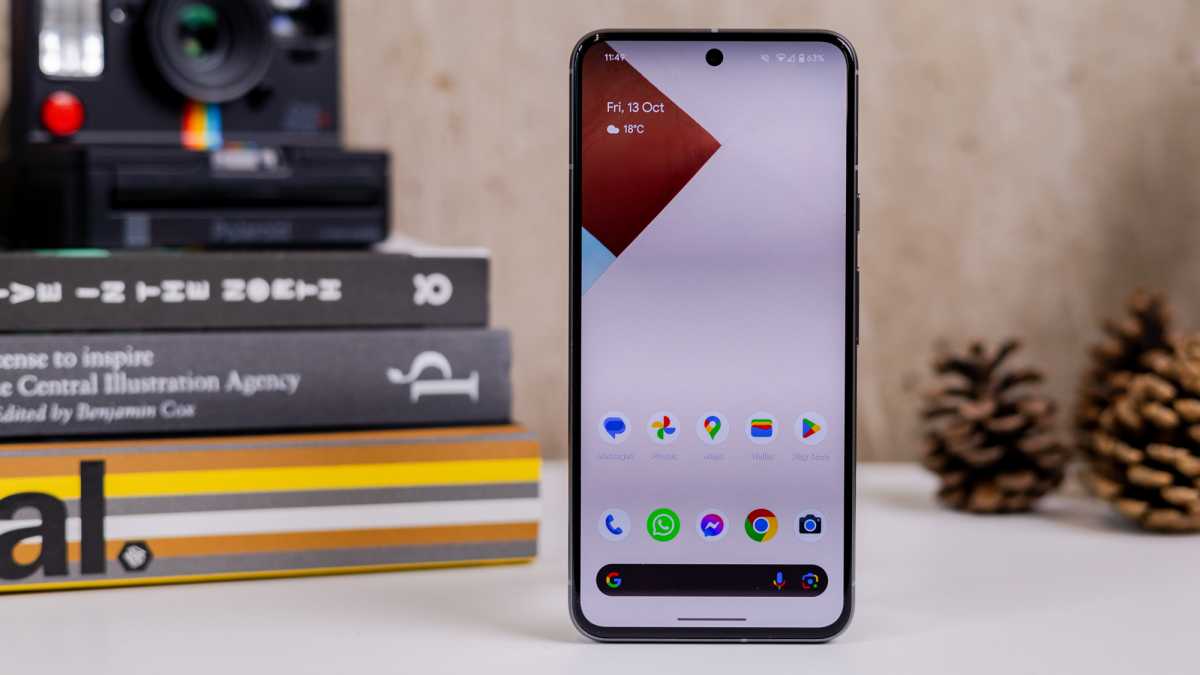
Dominik Tomaszewski / Foundry
I also prefer the rounded app icons and quick settings buttons, and you can add a nice splash of colour via themes and wallpapers. The latter even supports generative AI, meaning you can create a wallpaper that’s completely unique to you.
Call screening remains a Pixel-exclusive feature, and it’s a nice way to filter out spam calls or quickly receive a message (such as a package arriving) without needing to answer. I also particularly enjoy the Now Playing feature, which automatically identifies songs that are playing around you – even when offline.
In my opinion, the user experience on the Pixel 8 is the best you’ll find on any smartphone
Android 14 doesn’t introduce any huge changes, but new accessibility features, an updated share sheet and the option to use the flash as a notification light are all welcome.
But Google’s commitment to software support is extremely impressive. The company says the Pixel 8 will get seven years of both Android and security updates, taking it all the way up to Android 21 in 2030.
That’s the best of any Android phone maker, and a huge improvement on the Pixel 7’s three years of Android updates and five years of security updates and Samsung’s previously leading OS upgrade promise of four years – we just sincerely hope Google keeps its promise.
Battery Life & Charging
- 4575mAh battery
- Underwhelming battery life
- Only 27W charging
Battery life is undoubtedly the most disappointing thing about the Pixel 8. That speaks volumes about the quality of the phone, as it won’t be a dealbreaker for many people, but I was expecting better.
Google has equipped the phone with a 4575mAh cell, which is larger than the Pixel 7 (4355mAh) but significantly smaller than the Pixel 8 Pro (5050mAh). You can get a full day of battery life on a single charge, but only if you’re willing to tolerate battery anxiety or turn on battery saver mode towards the end of the day.
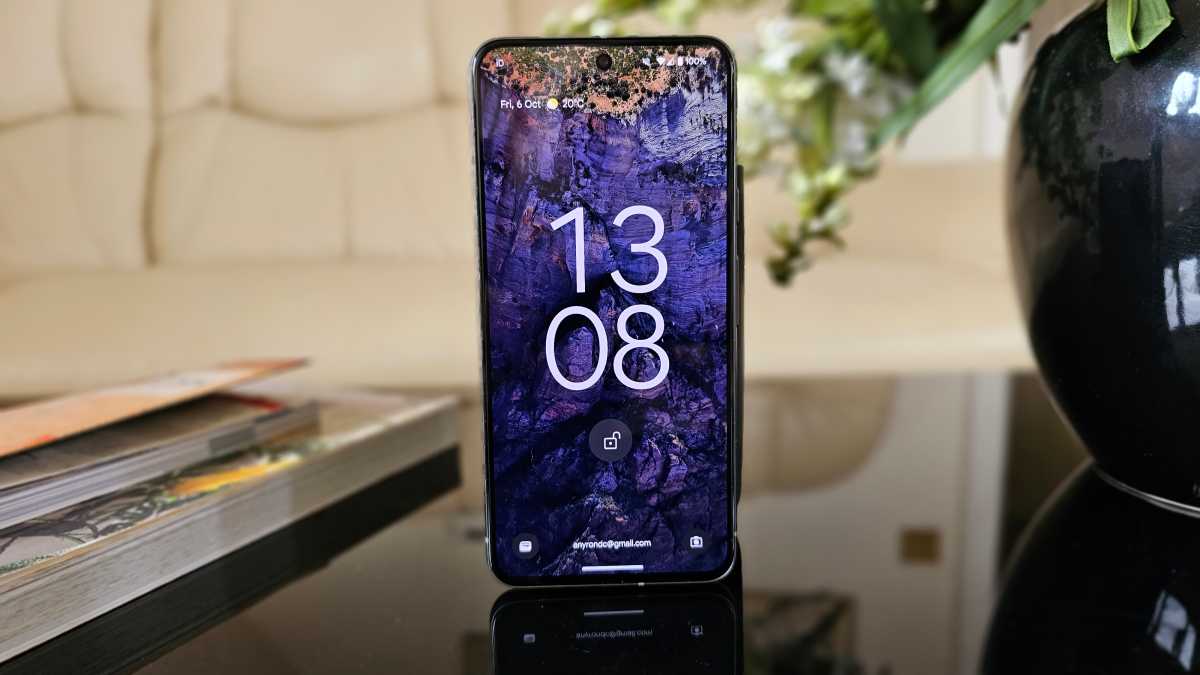
Anyron Copeman / Foundry
On those heavy usage days, with mobile data, location services and high screen brightness for several hours, you’ll need to find a power source as evening approaches. A score of 10 hours and 49 minutes in PCMark’s battery test is respectable, but it doesn’t reflect my real-world experience.
I think there are a few factors at play here. The first is a battery capacity that probably isn’t large enough to support such a powerful, bright phone. Another is the high refresh rate display and possibly the Tensor G3 chip, too.
And given Android 14 has only just been released at the time of writing, it may be a while before the software is optimised to deliver the best battery life.
Battery life is undoubtedly the most disappointing thing about the Pixel 8
Sadly, charging isn’t much better. The Pixel 8 is limited to speeds of just 27W, and there’s no charger included in the box, just a cable.
Using a 65W one I already had, the phone reached 23% in 15 minutes and 44% after half an hour, with a full charge taking around 85 minutes. Some modern phones charge almost three times as fast.
You do at least get 18W Qi wireless charging, plus slower reverse wireless charging for any other phone which supports the Qi standard.
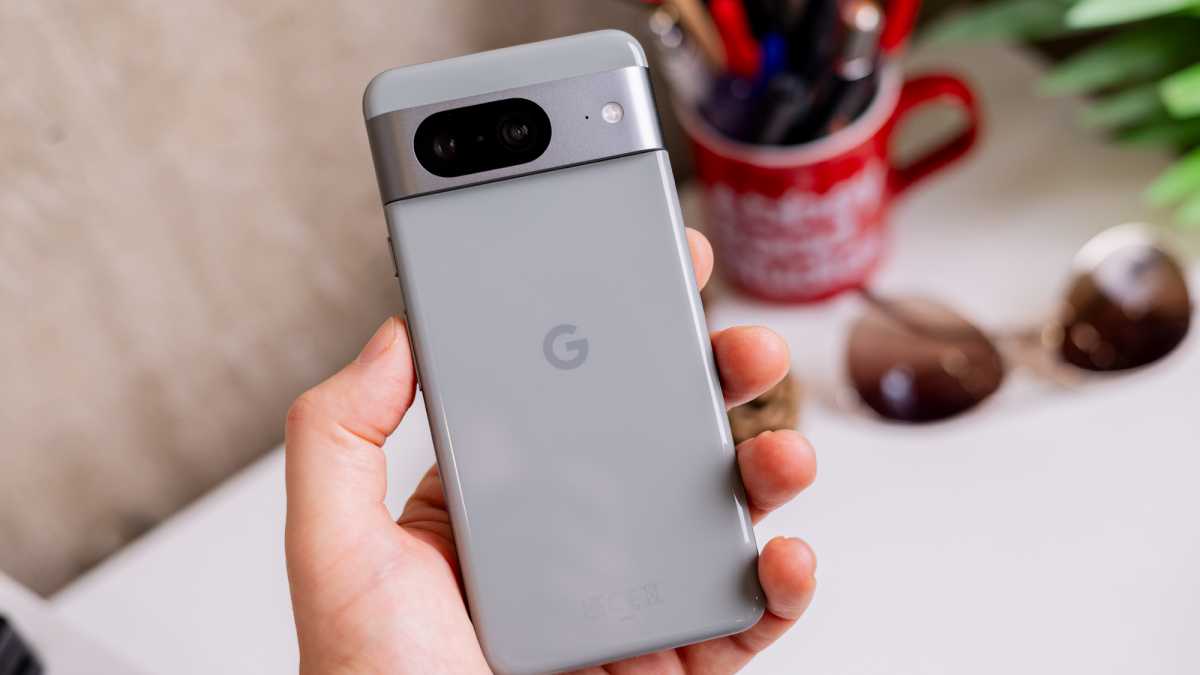
Dominik Tomaszewski / Foundry
Price & Availability
At launch, the Pixel 8 started at $699/£699. However, following the launch of the Pixel 9, it now starts at £599 in the UK, though the US starting price hasn’t changed.
That gets you the 128GB model I tested, but stepping up to 256GB will now cost you $759/£659. You can buy one from a variety of retailers in both the US and UK, including the Google Store and Amazon. But there are plenty of other options, whether you’re looking to buy the phone outright or on contract – see our dedicated Pixel 8 deals article for the full range.
It’s worth noting that the newer Pixel 9 is even more expensive, starting at $799/£799. But there are plenty of other alternative in our guide to the best smartphones.
Should you buy the Google Pixel 8?
That all depends on what you’re looking for. The Pixel 8 is a very good smartphone, but it’s certainly not right for everyone.
Superb main and selfie cameras cement its position as one of the finest camera phones you can buy, especially when combined with Google’s advanced software. However, you miss out on the Pixel 8 Pro’s 5x telephoto lens, and the ultrawide is a clear step down.
Google’s Tensor G3 chip is a pleasant surprise, delivering excellent performance in nearly every situation. But it’s not quite as fast as Qualcomm’s flagship Snapdragon 8 Gen 2.
There are no caveats to software, with the excellent Android 14 and an incredible seven years of OS and security updates. But the combination of disappointing battery life and slow charging holds it back a little.
And with so many features now exclusive to the Pixel 8 Pro, the regular model is much less appealing. It’s definitely still worth considering, but only if a compact design and great software are most important to you.
Specs
- 6.2in QHD+ 120Hz LTPO OLED display
- Google Tensor G3 chipset
- 8GB RAM
- 128/256GB non-expandable UFS 3.1 storage
- 4575mAh battery
- 27W wired charging
- 18W wireless charging
- 4.5W reverse wireless charging
- 50Mp f/1.68 main camera
- 12Mp f/2.2 ultrawide camera
- 10.5Mp f/2.2 front camera
- 5G
- Wi-Fi 7
- Bluetooth 5.3
- IP68
- Gorilla Glass Victus
- 150.5mm x 70.8mm x 8.9mm
- 187g
